A few weeks ago I ranked my personal top-five Beowulf films, and among them was Outlander, a semi-obscure 2008 alien-meets-Beowulf film starring Jim Caviezel. It ranked #3 not because I think it’s a very good film but because Beowulf films (outside of the amazing 13th Warrior) generally suck for one reason or another.
Anyway, every time I try to think of Outlander I find myself confusing it with Pathfinder, a 2007 film directed by Marcus Nispel starring Karl Urban. Since I was thinking about the one, I started thinking about the other and, well, here we are.
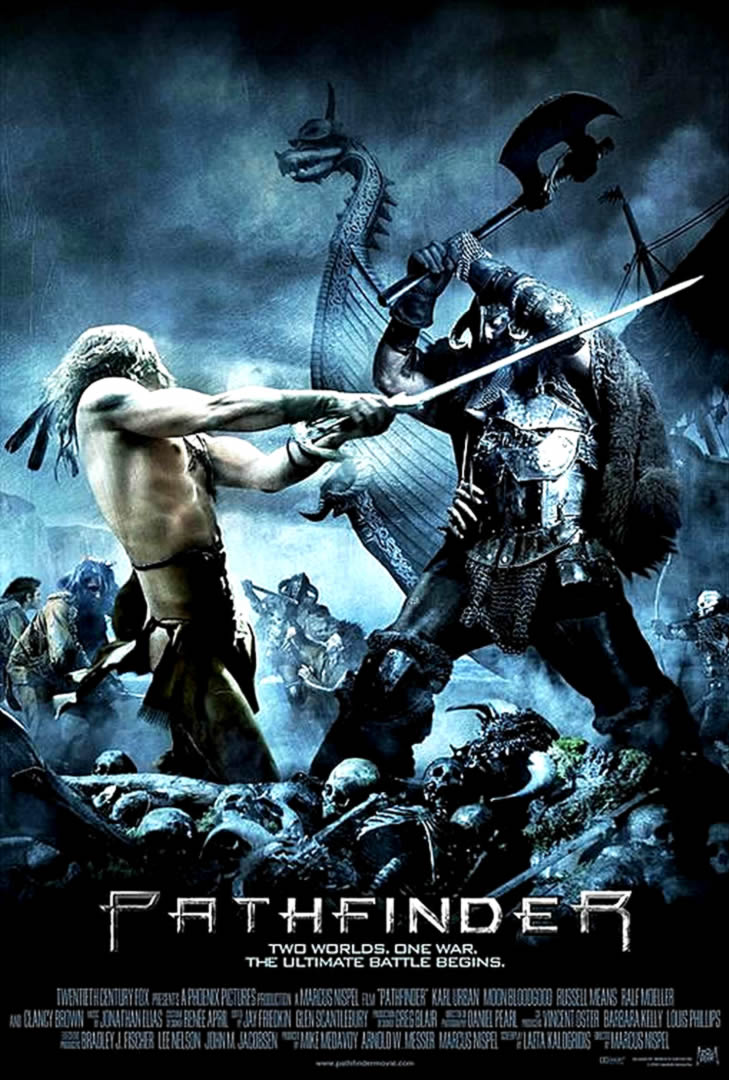
Pathfinder is loosely (oh so very loosely) based upon a historical fact: around the year 1000, Vikings made their way from Greenland to the shores of North America. They established a settlement, explored a little, and very certainly gathered wood that would be of tremendous use in Greenland. In time, however, they ran afoul of Native Americans whom they termed skraelings and were forced to abandon their settlement.
I say Pathfinder is “loosely based” on this because, well, the movie is pretty much full of crazy. Shovels and shovels of crazy.
Before I get to that, though, let’s go over what’s good about the film.
- It’s medieval-ish. It’s a low-bar, I know, but I almost always enjoy quasi-medieval things at least a little.
- For most of the movie the Vikings speak Icelandic, which is a decent approximation of Old Norse. Score.
- There are a couple of cool action pieces, including one where our hero slides down a mountainside on a Viking shield while fighting Vikings on Native American sleds.
I’m not kidding. It’s just…barrels of crazy.
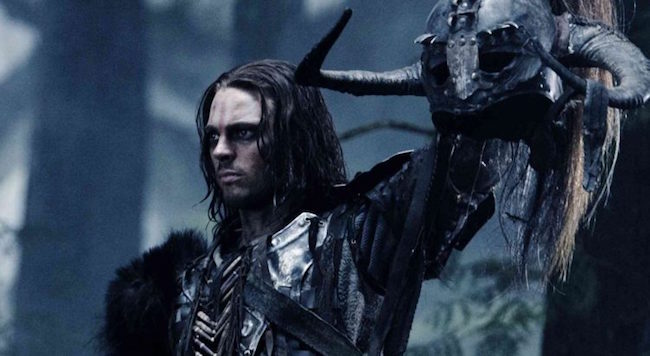
Let’s start with the movie’s plot. (Deep breath.)
A Native American woman is (of course) peacefully roaming a forested coastline when she stumbles upon a hulking, half-submerged ship. Upon investigation she finds it is full of dead people … except one traumatized young boy. He’s a Viking lad who was whipped and then left for dead by his Viking father because he refused to slaughter a native child. The Native American woman adopts him and names him Ghost.
Back home, the Native American leaders debate keeping Ghost around, but their “Pathfinder” (Russell Means, who is forever my Chingachgook because I watched Last of the Mohicans like a billion times) says there’s a spiritual tie between the boy and a prophecy.
Sadly, you can probably already see where this plot is heading.
Ghost grows up to be a strapping Karl Urban. And though he’s ostracized by many of the natives because he looks different, he’s still strapping Karl Urban.
Lo and behold, the Vikings return and attempt to eradicate the Native Americans in the most gruesome fashion they can imagine, including a lot of head-crunching, stake-burning, and one drawn-and-quartering. (I watched the film in its “Unrated” version, which clearly goes for “plus-plus-gore” throughout.)
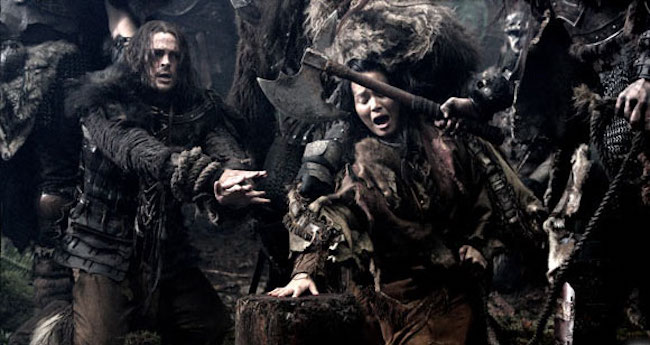
All would be lost, every native horrifyingly slaughtered by the inexorable might of the bulked-up, iron-armored tanks that are the Vikings … except that the poor besieged Native Americans are saved from their certain doom by the unmatched bravery and cleverness of the one white guy.
Naturally. I mean, ultimately, this guy’s from Norway, amirite?
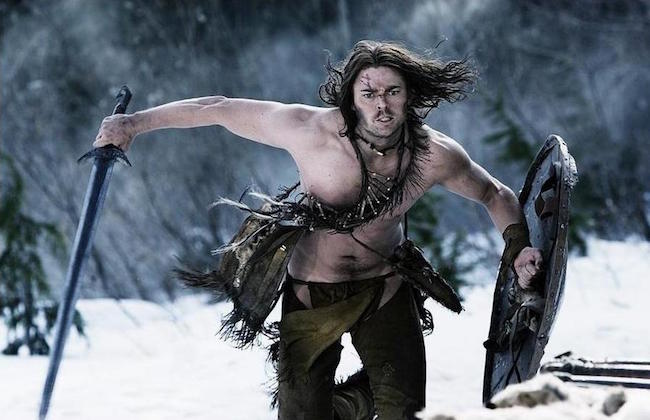
Oh, and did I mention that the hot native girl — played by Moon Bloodgood and named, um, Starfire — falls in love with him? Of course she does. To her credit, Bloodgood does a good job trying to sell Starfire’s feelings about Ghost, but there’s only so much she can do. Here’s the moment of their connection:
Starfire: There are two wolves fighting in each man’s heart. One is Love, the other is Hate.
Ghost: Which one wins?
Starfire: The one you feed the most.
[they kiss]
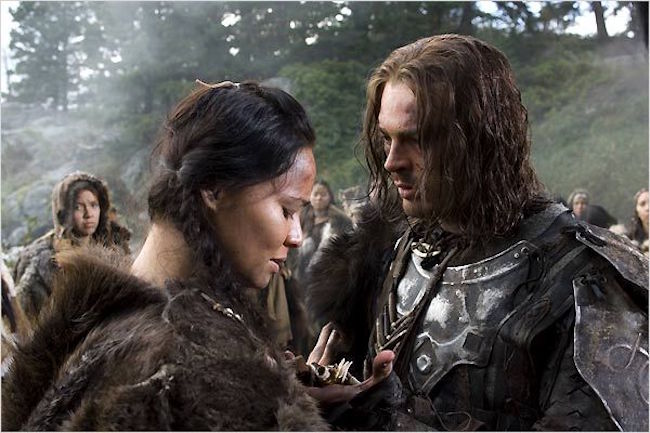
I want to say that this is pretty much a White Savior narrative at its worst—but I confess I’ve seen far, far worse. I mean, on the plus side, the film tries really super hard to make the Vikings (outside of strapping Karl) into the most awful dudes imaginable. The actors playing the main roles amid the evil Vikings — Clancy Brown and Ralf Moeller — have a lot of fun buying into these roles: they are intent on nothing less than the total annihilation of the Native Americans.
Oh, Gunnar (Clancy Brown) says something about this being necessary so that they can bring in more settlers, but given all the gleeful gore, one gets the sense that colonialization isn’t really on his or anyone else’s mind. It’s more about genocide, plain and simple.
Historical Vikings didn’t really operate like this, for what it’s worth. Yeah, they were hardly turn-the-other-cheek folks, but they generally weren’t interested in all the work involved in systematically engaging in an elaborate genocidal colonizing spree. The Viking philosophy was more akin to “get in, get what you need, and get out.”
Yet what this movie details is, make no mistake, quite elaborate and systematic. What we see at the beginning shows that they’ve come to the New World in absolutely massive ships with deep and wide cargo holds that are totally unlike Viking longboats. Indeed, though a few long-shots show longboats, the ship that baby-Urban is found in is like a Portuguese caravel (think Columbus’ Nina, Pinta, and Santa Maria), which makes sense: they’re not just bringing men and supplies but also teams of warhorses.
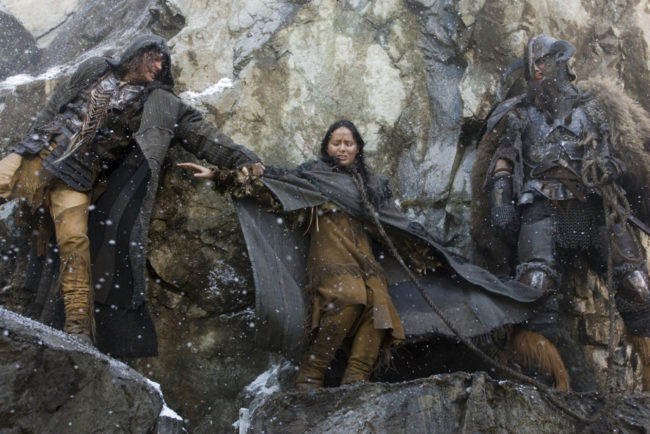
And oh so much armor. Armor for the men. Armor for their horses. Armor for their armor.
It’s mind-boggling how much plate these guys have. It’s like Gimli’s wet dream. And yeah, it looks cool in its way, but at a certain point it’s pretty much absurd to imagine the cost of having each Viking built into a lumbering tank, the weight of it, the feasibility of living in the get-up (they never take it off), and the sheer unhistorical nature of the whole thing.
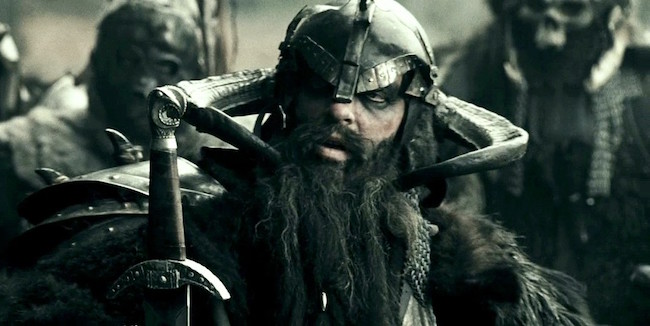
The Viking armaments are equally insane. Everything the Vikings carry has some kind of bling to it: blades are etched, edges are ground into menacing shapes (adding breaking points to the metal, huzzah!), spikes are stuck everywhere they can fit, handles are intricately designed … these are apparently the richest Vikings in history, with some kind of twisted Martha Stewart as their blacksmith.
And then there’s the flails. I want to blame this on Hollywood, but the problem is much bigger than that: I know a lot of well-meaning fantasy writers who just love their flails. Want some easy shorthand to convey that a fellow is menacing and cruel and evil? Give him a spiked ball-and-chain.
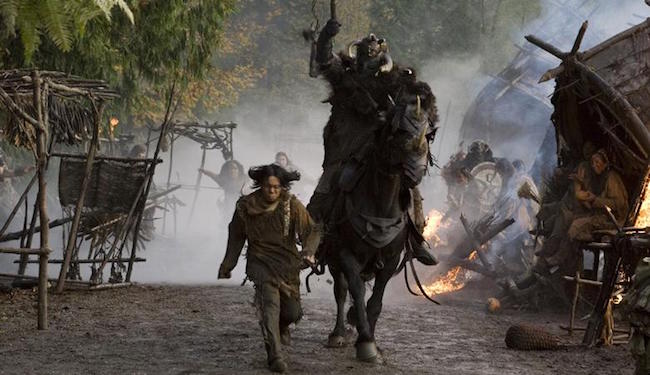
I get it. I feel you. But there are so very many things wrong with the use of these weapons in a real military context that many of us aren’t sure they were used for anything more than ceremony. So please try something else? Pretty please?
Mike’s Medieval Ratings
Authenticity: 1 of 10 spiked somethings
Just Plain Fun: 1 of 2 horns on a helm
 Michael Livingston is a Professor of Medieval Culture at The Citadel who has written extensively both on medieval history and on modern medievalism. His historical fantasy trilogy set in Ancient Rome, The Shards of Heaven, The Gates of Hell, and the newly released The Realms of God, is available from Tor Books.
Michael Livingston is a Professor of Medieval Culture at The Citadel who has written extensively both on medieval history and on modern medievalism. His historical fantasy trilogy set in Ancient Rome, The Shards of Heaven, The Gates of Hell, and the newly released The Realms of God, is available from Tor Books.











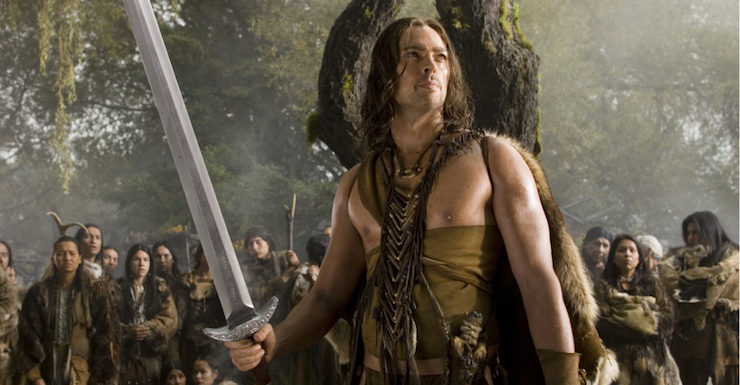
I thought this was about Pathfinder the RPG. Still, fun read.
Wait, that’s Karl Urban? He looks like Sebastian Stan in the picture where he’s holding up a helmet.
BTW, in the interest of accuracy, the caravels were Pinta, Niña, and Santa María. I’ll give you a pass on the “María”, since the i with a diacritic is just that; but the Ñ is a different letter than the N. You don’t want to make that mistake when writing “año” (year), as you turn it into “ano” (anus). Similarly, “Nina” means nothing in Spanish, while “Niña” means “Girl”.
Wasn’t the film a remake of the Sami-Norwegian 1987 film of the same name by Nils Gaup? That one didn’t have a white saviour. The hero was a Sami like everybody else.
Sounds awful. As I recall the Greenlander’s Saga the Vikings got their asses kicked by the Skraelings and skedaddled. There were easier and richer places to raid.
Moon Bloodgood is a hell of a name.
I vaguely recall this movie coming out, and then nothing else about it until now which seems fair based on your review.
@@@@@ 4, Moon Bloodgood sounds kind of phony to me. In my study of anthropology I learned that real Indian names were generally a lot less poetic and evocative than the fictional kind. Ms. Bloodgood may have adopted the kind of name white folks expect for her career.
I’d really like to know more about the impracticality of flails.
@5 From IMDB: “Birth Name: Korinna Moon Bloodgood”, and “Moon’s father, who is American-born, has Dutch, English, Welsh, and Irish ancestry. The surname “Bloodgood”, originally spelled “Bloetgoet”, is Dutch. Moon’s mother is Korean-born.”
@5, Per Ms. Bloodgood’s imdb page, Moon is her middle name and “the surname “Bloodgood”, originally spelled “Bloetgoet”, is Dutch” (from her father’s side. Her mother was born in Korea). The character name of “Starfire”, however……
@1, Now I really want the Mark Hamill as Sebastian’s Stan’s Father meme to grow to include Karl Urban as Sebastian Stan’s Uncle……
It’s a shame that’s such a crappy movie because there must be an interesting story to be told about the Scandinavians who came to what is now Canada.
I’ve read that they didn’t establish a permanent settlement largely because they couldn’t make peace with the locals there. But it’s not as if they were exactly welcomed by the Gaels, Anglo-Saxons, Franks, etc either and yet that didn’t deter them from repeatedly attacking their lands and eventually settling some people there. So I don’t get why they didn’t persist in North America. Perhaps its just unknown, given the paucity of archeological evidence or textual sources, but “The Indians weren’t friendly” doesn’t seem to cut it as an explanation.
@9 It may just have been a cost-benefit analysis. The trip may have been too long for any trade benefit they could get (even if they needed timber for Greenland, how many longboats worth of timber could a longboat carry as cargo? Plus sailors and provisions.)
And if the locals raided their food stores and wrecked their farms, that would have made it near-impossible even without coming into open armed conflict.
This movie is a remake of the Sami movie, for very low values of “remake”. The original is amazing, and as far as I know, the only movie ever made in the Sami (Lapp) language.
The “remake” is trash, but trashy, gory fun, if you like this sort of thing. But it makes Viking Women vs. the Sea Serpent look like a documentary.
There is an earlier Sami movie, Scandinature’s 2004 version of Macbeth. The 10 minutes released online look amazing but I haven’t been able to track down the whole film.
Grabbed this movie out of a bargain bin because, well… Vikings, Indians, Clancy Brown… I’ll risk $3 for that. While my wife and I totally enjoyed it I can’t argue with ANY of the criticisms in the article or comments here. Even though the blurb said it was based on a real legend we decided to think of it as a non-magical fantasy action flick.
Made me think of the Outlander books by Diana Galbadon.
6, Flails are heavy and hard to use, they might well endanger the person using them, their allies, or just slam into the ground. Obviously the flail, as descended from the agricultural instrument WAS used, but the depiction of them may not be strictly accurate.
13, real legend, um, yeah, there were Vikings, I guess.
Though they did have settlements and colonies in certain places, they weren’t all raiders.
@9
Logistics. The places you mention are close to the raiders base of operations, scandinavia, and eventually some of those places became bases of operations in their own right for future raids further out.
The Norse forays to North America were not launched from the scandinavian homeland or any of the nearby areas they occupied. Those forays were launched from Iceland and Greenland, which had very small populations and could never support more than exploring and resource gathering parties.
Had the scandinavians come in force I think that the diseases brought by europeans five hundred years later would have simply gotten an earlier start. It was not going to end well for natives either way
@9,
Remember that the Norse who made it to North America were operating out of Greenland, which was itself at the end of a loooooong logistical train. Most Viking conquests in Europe were just a few days sail from a homebase. Wanna invade England from Denmark? Sail roughly west and south for 4 days. Wanne invade America from Greenland? Start counting in weeks not days. And while you could reasonably land several hundred to several thousand warriors (depending on the sources) in England it took massive numbers of ships. The Greenlanders had at most 5000 people (more likely less than that) at the height of the settlement and very few ships. It just wasn’t gonna be a war of conquest when you can land maybe 30 people over 1300 NM from Greenland. The settlement – if you can call it that – at L’anse Aux Medows was 3 buildings and they were there for maybe 10 years.
@13/AverageJoe: I’ve heard that the Nils Gaup film was based on a legend his grandfather had told him when he was a boy. Of course, that would make it a Sami legend, not a Native American one.
There was also a graphic novel adaptation of this. The art is very moody and atmospheric, but the story, as in the film, is a mess.
Regarding the excessive, overly ornate armor and weapons, I seem to recall reading an interview with the filmmakers indicating that they had no pretensions of historical accuracy. They wanted the Vikings to look like they stepped out of a Frazetta painting. Mission accomplished.
I saw this when it came out. I didn’t like the white saviour aspects, but the part that really gets me is how the heck the protagonist learns to sword fight better than the Vikings. After all, he has no one to teach him or to spar with. How could he ever get good?
@@@@@ 7. Thank you. Silly of me to assume she was a real native American.
I sat through most of this movie patiently waiting for the fun bit with the monster, which was surely coming any minute now, before realising that I had confused it with Outlander.
I was very disappointed.
Supposedly, the Skraelings turned on the Vikings shortly after being invited to a feast. After finding evidence of dairy animals at the site, someone suggested the Skraelings, who would likely all have been lactose intolerant, thought the Vikings tried to poison them. I told that theory to a lactose intolerant friend. She said she’d have tried to kill the Vikings, too.
OK, I want to see a movie where people are yelling, “Kill all the cows!” and “Spare none of the sheep!”
Do you think moviemakers ever ask themselves this question with regard to armor on Vikings: If you spent much of your life in a boat going from one place to another, how much sure-to-ensure-you-drown-if-something-bad-happens-with-the-boat armor would you wear?
Regarding armor, the Vikings almost certainly would have been very heavily armored. They would not have had plate armor, naturally, but mail hauberks akin to those used throughout Europe and the Middle East during the period would have been practically required, unless they were incredibly poor and unable to afford the basic tools of their trade. IIRC by this time the pattern of mail generally had been advanced to the “doubled” stage, which seems to be quite confusing in the literature I’ve read. Some people theorized that doubled mail meant mutli-layered (essentially wearing two sets of mail, one over the other), but the best explanation for it that I’ve come across is that extra links were included (doubling of the links in the weave, essentially), which made it denser and heavier without hurting its flexibility and while making it less vulnerable to piercing blows and to damage in general.
Considering that mail goes back to the ancient Celts and was spread across the entire face of the Eurasian world, expecting Vikings to be unprotected just because they were shipboard is unrealistic. Would you really choose to forego the best form of protection available on the slight chance that it might make it just hard enough to swim that you would drown should your ship go down (which if that happens you’re basically dead anyway, even if you can swim, since it is the North Atlantic we’re talking about here)? Even if that were the case, certainly once you beached your ship you’d put your armor on before going ashore to face hostiles.
Personally I prefer it when Vikings are depicted with too much armor rather than not enough. Too much is artistic license, but not enough means the characters are just idiots with a death wish. That said, why anyone would want to make stuff up when the real thing is so beautiful and amazing looking is beyond me.
Karl Urban is in some of the worst trash imaginable, isn’t he? Either he is a completely fantasy nerd who does this stuff for giggles or he needs to have a long talk with his agent.
25, from what I understand, he claims otherwise, but he did actually seek out the role in Star Trek, which at least makes him willing to hustle after such things, though that’s Star Trek, so…
@6 Well it depends on the context… ;) Here’s Matt Easton of the scholagladiatoria channel to help.
https://youtu.be/AGf7n7iUF_k
@22,
I doubt if the Vikings were shoving raw milk down the First People’s throats, and many cheeses no longer have lactose; the bacteria have eaten it all. On the other hand, the Vikings had a well-deserved reputation for aggression and brutality. They’d probably have already killed and tortured a few of the locals before the feast, and the Skraelings had already decided they’d had enough. As an aside, quite a few Europeans are — and were — lactose-intolerant, and drinking milk was probably not quite so common then as it is today.
@23,
Regarding armor in a boat. Well, first, if the boat sinks or breaks up — which most certainly happened — one will not survive very long in the North Atlantic, so being drowned quickly may be seen as a better option than treading water until the orcas or sharks notice lunch. Second, they’d probably row or sail with the armor off until close to shore.
—-
More generally, one should remember that the native peoples of North America were not in some conflict-free paradise. European settlers — and possibly the Vikings — exploited existing conflicts, possibly worsening them, but the idea that the native peoples of North America were conflict-free children of nature is nonsensical.
Just one more thing…..First Peoples, at least as late as the 18th Centuries, would seize captives. I suspect that many of the captives, once adopted into families, found life among the First Peoples to be less restrictive and more equitable than in European settler society, For one thing, women probably had more agency in First Peoples’ societies
@28, Your last point depends entirely on the tribe. Indian captivity could also be pretty grisly they weren’t always adopted as full members of the tribe. Slavery was practiced by many first Nations and torture of prisoners and rape were not uncommon.
The term in general is captivity narrative though of course, many are fake, exaggerated, or generally unreliable, and the situation often worked the other way.
@24.
Yep, it’s been well established that you can wriggle out of a mailshirt underwater quick enough to swim to the surface, and seafarers tended to like a looser design for that reason. Unlike the shiny painted wool tight fitting garmentHollywood portrays them as. And also presuming the person could swim.
@30, child captives seem as a rule to have had an easier time being adopted into the tribe. Adults often suffered mistreatment or at the least were unable to adapt.
A happy empowering captivity among noble savages is a modern trope. Great sex is usually a fringe benefit.
@29, and, no doubt, the time,the tribe, and the level and type of conflict, and the utility of the captive. Also, no doubt, the captives were severely acculturated and frequently unable to re-integrate into European/North American society; if one was captured at a young age and never saw any family or former neighbors, “returning” to European society would be to leave the only life one knew.
@31, even if one could swim, the North Atlantic is cold and humans can’t swim for more than a few miles.
@33
Hah. The Baltic is bloody cold even in late summer – 28* in the air, 12* in the water. My feet cramped just walking in the shallows, and people were doing laps in it in speedos. Nordic people are crazy.
But most Vikings who grew up on the coasts learned to swim as a matter of course, though the inland ones may not have. There are plenty of records from sagas of endurance contests. Once you get past the initial cold shock, most people can easily survive for 10-20min in 5* water before losing coordination, though I’d expect hypothermia to set in fast on an open boat.
Unlike a classic high sided sailing ship, a Viking longship was double ended, had a single sail, oars that can be rapidly shipped and low gunwales – if a man falls overboard he only has to swim long enough for them to quickly stop and row back for him, and it’s straightforward to pull him over the side. Fall overboard from a tall ship, and it’d take half an hour to wear ship back to that point or lower a boat and crew, assuming the captain cared enough to try. Hence why swimming went out of fashion with the average crew and why modern sailing ships carry lots of handy floatation aids to buy them time.
But yes, I’d expect the armour and weapons to be stored just above the bilges until needed for a battle – if nothing else keeping the weight low an central would help stabilise the ship.
Going to say I don’t know about the lactose intolerance thing, just that it was a theory I heard put forward. However, as I understand it, the Vikings could also be pretty intelligent traders. They (obviously) didn’t have a problem with some raiding and pillaging but they weren’t idiots and knew how to behave themselves.
As for it making sense, they would have been a small group whose nearest backup was weeks away in an area where they were severely outnumbered. They also didn’t have as much of a technological edge as later Europeans would have. I would expect them to make nice and try to maintain friendly trade relations.
Granted, I also like the idea of the Vikings being baffled about what went wrong. It’s more fun to wonder what the Vikings could have done wrong without knowing they were doing it than coming away with an answer like, “Too much genocide.”
Side thing on the issue of Indian captives: Conditions varied, and there are some gruesome stories, but the League of the Iroquois had a reputation for avoiding sexual assault. This was because they had a complex incest taboo. As I understand it, anyone from either parent’s tribe was off limits, as far as sex went–and captives could be adopted into any tribe. At that point, the taboo kicked in retroactively. If a man slept with a captive who was later adopted into his tribe, he was guilty of incest.
@11, Aleksandr Rogozhkin’s The Cuckoo (Кукушка, 2002) is a film in Russian, Finnish, and Sami, and it’s wonderful. It’s set in Finland during the Continuation War. None of the three characters understands the language of the others. The audience, fortunately, has subtitles.
@36/Sovay: Oh yes. One of my favourite films. It has three very likeable characters, a Sami woman and a Finnish and a Russian soldier, who keep misunderstanding each other because they assume that they know what the other one is talking about. This makes for some comedic moments, but also one almost-tragedy.
If you liked /hated this you’ll REALLY like/hate 1978’s “The Norseman” starring Lee Majors.
http://www.imdb.com/title/tt0078007/?ref_=nm_flmg_act_100
@28
I seriously doubt the Norse who landed in North America were out for conquest and mayhem. They had one boat with maybe 30 people on it. They weren’t stupid.
@39/ragnarredbeard: This number seems a bit low, given that the settlement excavated in Newfoundland had eleven houses.
@40
As far as I know, L’anse Aux Meadows has 8 buildings, 5 of which were workshops or storage.
That’s what Wikipedia said, also it could have housed anywhere between 30 and150 people. The higher figure is the less likely
@41-42: You’re right! German Wikipedia said “eleven houses and one smithy”, and that’s where I got my number. But the English Wikipedia entry is much more detailed, so it’s probably the correct one.
An interesting example of how available information can alter one’s perceptions.
@27: Thanks for the link.
@25: Depends on what you consider “trash”. I thought he was really good in Dredd. And in RED. Also in Almost Human, which sadly got canceled prematurely. But really, look at almost any actor’s resume and you’ll find at least one or two stinkers.
@35,
I personally, and with little evidence, consider it nonsense. While politeness may require one to eat or drink unpalatable and strange food (I’ve done so :-0), it doesn’t require one to gorge on it. Also, the native peoples would probably expect that they’d get some stomach upset from strange food and assume it was just because the Vikings ate weird stuff, not that they were malign. After all, even today, quite experienced mushroom hunters die or get quite sick from mistaken identity, and I’ve no doubt that would have happened to native peoples.
Also, the Vikings would brew beer and mead. It may not have been the lactose intolerance, but the hangovers that made the Skraelings angry, as if having a few dozen random people set up housekeeping in your territory wasn’t enough.
Not sure how to interpret the title “White savior nonsense”. If this wasn’t intended as a slight on white people’s protrayal in movies, then don’t bother reading the rest of my comment.
So are you seriously pissed off that a white guy got to play a good guy for once instead of the regular roles which Hollywood usually casts us as? You know, racist genocidal lunatics who came to the Americas because they just love killing Indians as oppose to the reality which is that most of the colonists were simply entrepreneurs with good intentions who unfortunately ended up bringing not yet understood diseases to the continent which whiped out many Indians before the first whites ever set foot on land. (Look it up. Most of the diseases were spread by Seals)
Or are you going to pretend this is about historical accuracy? In which case why aren’t you complaining about the so called “native” Americans (who aren’t really native at all). Who are always portrayed as peacefull pacifists minding their own business who were brutally victimized, whereas in reality many of the tribes were just a bunch of bloodthirsty cutthroats who scalped women and children on a regular basis and were all too happy to pick sides and fight alongside the colonists and conquistadors against their own people. Even the horrific genocidal ones which admittedly did exist.
@39 Of course not, and nor where the later Spanish and English colonists. This is just nonsense and myths designed to cultivate white guilt.
The overwhelming majority of the colonists were entrepreneurs with good intentions who went there to trade and set up farms. The fact that they ended up bringing diseases along with them is unfortunate but they can’t be blamed for that as the germ theory of disease wasn’t fully developped at that time. (BTW the story about the English colonists handing out blankets laced with smallpox is a myth)
That’s not to say that there weren’t a few (mainly Spanish) psychopaths who went there simply to slaughter and kill. But this was always frowned upon and Charles V himself tried everything he could to stop this bloodshed.
The truth is that the horrors surrounding the colonization of America are grossly exagerated. As a whole the atrocities which were comitted were no worse than the Iraq war or Vietnam and certainly a lot more morally grey (as the Indians were also very violent and competent warriors). The idea that there was a genocide at all is also a myth, as most native Americans interbred with Whites this is what caused the fullblooded population to decline.
I don’t know about the good intentions but people certainly didn’t go to the Americas just to kill Indians. Or even particularly want to once they were there.
Powhatan was an American Caesar intent on creating an empire. He saw the Jamestown settlers as a useful resource with their guns. The Pilgrims and the local indians got along well for some forty years until the colonists growing numbers alarmed King Philip. No innocent pacifists here.
Years ago I turned on this movie totally by accident. However, despite obvious historical discrepancies of both Native Americans and Vikings it produced a compelling action film. In addition, Karl Urban, Russell Means and Blood Moonglow performed reasonably well. I think we need to remember this wasn’t done as any historical documentary but a piece of entertainment and in that it accomplished its goal.
@49 Yeah, one of my major issues with postcolonial theory, particularly when it relates to Canada’s First Nations, is that there’s this increasing tendency to act like every single person who’s ever come to this country, from les filles du Roi to Syrian refugees and everyone in between, has done so for the singular and express purpose of screwing over the indigenous population. It’s overly simplistic and both casts every newcomer, no matter their epoch, as monsters while simultaneously Othering the indigenous peoples they’re supposedly standing up for.
“a white guy got to play a good guy for once”
LOL. Yes, white guys never get to be good guys in Hollywood except for *all the time*, sometimes even when the original character was not white.
“Most of the diseases were spread by Seals”
*Seals*? Oh lord, what madness is this? If you said pigs you might have a point, at least in the future SE USA.
“The overwhelming majority of the colonists were entrepreneurs with good intentions who went there to trade and set up farms”
Set up farms on someone else’s land. Often farmed by slaves, first Indian ones and then African ones. And you’re ignoring the gold rush of both Spanish and English colonies.
“The truth is that the horrors surrounding the colonization of America are grossly exagerated.”
The truth is that many such horrors are barely taught, especially those committed by Columbus, which rival Leopold’s crimes in the Congo. The early Carolinas prospered by exporting Indian slaves to the sugar plantations of the Caribbean.
“many of the tribes were just a bunch of bloodthirsty cutthroats who scalped women and children on a regular basis”
With that level of accuracy, many of the colonists were just a bunch of filthy bloodthirsty cutthroats who would take and rape slaves on a regular basis, or cut off hands for not bringing them enough gold, and break treaties as it pleased them.
“The idea that there was a genocide at all is also a myth, as most native Americans interbred with Whites this is what caused the fullblooded population to decline.”
No, the massive diseases killed off most of the population. You can’t even stick to a consistent excuse for the white invaders.
@48,
Intermarriage no doubt happened, but — and this is an important but — it was likely far less common in British North America than it was in Spanish and Portuguese and, likely, French settlements. This is one of the reason that South and Central American Spanish have many words for people ancestry: white + Native American, white + African, African + Native, and combinations of those (there were also words to distinguish those born in Spain from those born in the Americas: peninsulares would outrank criollos in the social scheme of things.
Smallpox and measles were diseases that were unknown in the New World prior to the arrival of Europeans; the former has a quite high mortality rate well into the modern era — iirc, it’s about 30%* — and even with post-WW2 levels of medical aid in the First World, measles has a fatality rate over 0.1% and higher rates of permanent disability, including TBI, blindness, and deafness**.
Even if it wasn’t deliberate — and it’s unlikely a group that couldn’t correlate rats and general filth with plague would be terribly conscious of the idea of contagion — some of the native populations had mortality rates due to Old World diseases of 90%, After King Philip’s War***, the Native Americans on the losing side were executed or sold into slavery. Those on the winning side (the settlers had Native America allies) were forced to relocate onto reservations.
———-
* See, for example, https://www.health.mil/Military-Health-Topics/Health-Readiness/Immunization-Healthcare/Vaccine-Preventable-Diseases/Smallpox
** See https://www.cdc.gov/measles/about/parents-top4.html and https://www.aao.org/eye-health/tips-prevention/six-ways-measles-can-affect-eyes-2
*** It’s not terribly easy to find histories that cover King Philip’s War, but the causes seem to be centered around to a change in settler leadership, leading to an inability to negotiate solutions to problems between the native peoples and the settlers. King Philip’s War was no less than the third between settlers and native peoples: the first was between the Jamestown settlers and the surrounding peoples, largely because the Jamestown inhabitants felt that armed robbery was the preferred method of acquiring food.
The Legend is the pale rider and the White horse I Heard it to im half Mexican Cherokee
@@@@@ 4, Porphyrogenitus:
Regarding armor, the Vikings almost certainly would have been very heavily armored. They would not have had plate armor, naturally, but mail hauberks akin to those used throughout Europe and the Middle East during the period would have been practically required, unless they were incredibly poor and unable to afford the basic tools of their trade.
Just how rich do you think your average Viking was? At home, the basic tool of his trade was the plow. The commonest Viking battle tools were spears and axes. Much cheaper than fancy-pants swords. Link mail was expensive stuff, and hard to maintain on shipboard.
Why bother when they could kill cattle and make leather. Then turn the leather into cuir-bouilli armor. (Soak leather in cold water. Stick it into boiling water. If you’re putting on the dog, dip it in hot wax—but water is cheaper. Shape into a breastplate or vambrace. Let it dry.) That gave protection nearly as good as link mail, at a cost any farmer could afford. Even better, it wasn’t an anchor if he fell overboard during a sea-battle.
@@@@@ 22, Ellynne:
OK, I want to see a movie where people are yelling, “Kill all the cows!” and “Spare none of the sheep!”
When Tecumseh was gathering an Indian alliance to fight the Americans, an old shaman known to history as Charlie approached the Cherokee. He demanded that they rid themselves of all the white man’s ways and works. “Go back to the old ways—cast off the European clothes, abandon the crops, stop drinking firewater, kill the cats.”
@@@@@ 52, zdamien:
“Most of the diseases were spread by Seals”
*Seals*? Oh lord, what madness is this? If you said pigs you might have a point, at least in the future SE USA.
The Spanish left breeding pairs of pigs wherever they went. If they returned to an island so colonized, there were plenty of pigs for them to harvest.
Pigs did more than just spread disease. They were a prolific and invasive species. The natives were unprepared to deal with them. Hunting wild boar was a good way to end up dead. Feral pigs were living bulldozers. They disturbed the local ecological balance, which wrecked local farming methods. European pandemics, plus sounders of swine, made a devastating one-two punch.
@57,
Interesting, that, especially since the Northeast Woodland tribes were largely agricultural, with permanent villages and cultured crops before Europeans arrived
@@@@@ 59, swampyankee
Interesting, that, especially since the Northeast Woodland tribes were largely agricultural, with permanent villages and cultured crops before Europeans arrived
Charlie wasn’t preaching against the traditional crops. Maize and squash and such.
Just the new ones introduced by the Spanish/British/French/Americans. Things like wheat and rye and barley. He objected to the Cherokee adopting house cats for the same reason. Anything gotten from the white man was bad.
Almost. If he preached giving up firearms, I never heard tell of it.
The film is loosely, very loosely based on a Norwegian film that is based on Sámi legend. The Norwegian film had the same title in English “Pathfinder” and Veiviseren in Norwegian. In the original film it is a Sámi boy escaping invaders after they have killed his family and then trying to protect other Sámi tribes.
There is an English dub version available on YouTube. It’s hard to find otherwise.
Despite being based on legend the story is more likely more historically correct. Just reading about this new version makes me upset.